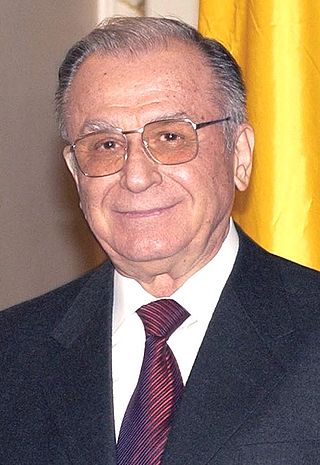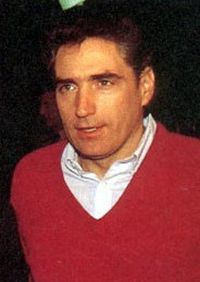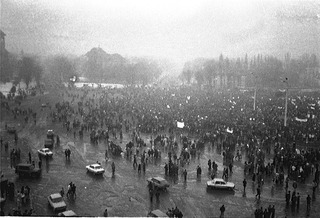
Ion Iliescu is a Romanian politician and engineer who served as President of Romania from 1989 until 1996 and from 2000 until 2004. Between 1996 and 2000 and also from 2004 to 2008, the year in which he retired, Iliescu was a senator for the Social Democratic Party (PSD), of which he is the founder and honorary president to this day.
After the Communist rulership ended and the former Communist dictator Nicolae Ceaușescu was executed in the midst of the bloody Romanian Revolution of December 1989, the National Salvation Front (FSN) seized power, led by Ion Iliescu. The FSN transformed itself into a massive political party in short time and overwhelmingly won the general election of May 1990, with Iliescu as president. These first months of 1990 were marked by violent protests and counter-protests, involving most notably the tremendously violent and brutal coal miners of the Jiu Valley which were called by Iliescu himself and the FSN to crush peaceful protesters in the University Square in Bucharest.

Râmnicu Vâlcea is the county seat town and also the largest urban settlement of Vâlcea County, central-southern Romania.

Emil Constantinescu is a Romanian professor and politician, who served as the President of Romania, from 1996 to 2000.

Petre Roman is a Romanian engineer and politician who was Prime Minister of Romania from 1989 to 1991, when his government was overthrown by the intervention of the miners led by Miron Cozma in the September 1991 Mineriad. Although regarded as the first Romanian prime minister since 1945 who was not a communist or communist sympathiser, he was a socialist. He was also the president of the Senate from 1996 to 1999 and Minister of Foreign Affairs from 1999 to 2000.

Justinian Marina was a Romanian Orthodox prelate. He was the third patriarch of the Romanian Orthodox Church, serving between 1948 and 1977.

The mineriads were a series of protests and often violent altercations by Jiu Valley miners in Bucharest during the 1990s, particularly 1990–91. The term "mineriad" is also used to refer to the most significant and violent of these encounters, which occurred June 13–15, 1990. During the 1990s, the Jiu Valley miners played a visible role in Romanian politics, and their protests reflected inter-political and societal struggles after the Romanian Revolution.

The Jiu Valley is a region in southwestern Transylvania, Romania, in Hunedoara county, situated in a valley of the Jiu River between the Retezat Mountains and the Parâng Mountains. The region was heavily industrialised and the main activity was coal mining, but due to low efficiency, most of the mines were closed down in the years following the collapse of Communism in Romania. For a long time the place was called Romania's biggest coalfield.

Vintilă Ion Constantin Brătianu was a Romanian politician who served as Prime Minister of Romania between 24 November 1927 and 9 November 1928. He and his brothers Ion I. C. Brătianu and Dinu Brătianu were the leaders of the National Liberal Party of Romania, founded by their father, Ion C. Brătianu.

Miron Cozma is a former Romanian labor-union organizer and politician, and leader of Romania's Jiu Valley coal miners' union. He is best known for his leading the miners of the Jiu Valley during the September 1991 Mineriad which overthrew the reformist Petre Roman government. Cozma was a controversial character in the 1990s, both within and outside of Jiu Valley.
The June 1990 Mineriad was the suppression of anti-National Salvation Front (FSN) rioting in Bucharest, Romania by the physical intervention of groups of industrial workers as well as coal miners from the Jiu Valley, brought to Bucharest by the government to counter the rising violence of the protesters. This event occurred several weeks after the FSN achieved a landslide victory in the May 1990 general election, the first elections after the fall of the communist regime of Nicolae Ceaușescu. Many of the miners, factory workers, and other anti-protester groups, fought with the protesters and bystanders. The violence resulted in some deaths and many injuries on both sides of the confrontations. Official figures listed seven fatalities and hundreds of injured, although media estimates of the number killed and injured varied widely and were often much higher.

The 2012 Romanian protests were a series of protests and civil manifestations triggered by the introduction of new health reform legislation. In particular, President Traian Băsescu criticized the Deputy Minister of Health, Raed Arafat, on a Romanian television broadcast. The protests became violent, with both protesters and members of the Gendarmerie sustaining injuries during their clashes.
September 1991 Mineriad was a political action and physical confrontation between the miners of the Jiu Valley and the Romanian authorities, that led to the resignation of Prime Minister Petre Roman's government. Led by Miron Cozma, president of the Jiu Valley Coal Miners Union, the miners engaged in a series of actions beginning in the 1990s referred to as "mineriads" whereby large numbers of miners traveled to the Romanian capital of Bucharest and engaged in demonstrations and sometimes violent confrontations against counter-demonstrators and government authorities.
This is a list of 1990 events that occurred in Romania.
This is a list of 1999 events that occurred in Romania.

The February 1990 Mineriad was a mineriad that occurred in Bucharest, the capital of Romania. Although it was at first non-violent, the protests later escalated. This Mineriad happened 18–19 February, less than a month after the January 1990 Mineriad. Despite the demonstrators' pleas to non-violence, several persons started throwing stones into the Victoria Palace Government building. Riot police and army forces intervened to restore order, and on the same night, 4,000 miners headed to Bucharest. Opposition leaders and independent media speculated that the demonstration was manipulated by the Securitate and the National Salvation Front. Miners maintained their relative innocence of the violence, claiming that the agitation and most of the brutality was the work of Ion Iliescu's government agents who had infiltrated and disguised themselves as miners.
The February 1999 Mineriad was the last of the six mineriads that occurred in Romania. It began on 16 February 1999, when 2,000–2,500 miners from the Jiu Valley left for Bucharest in around 50 buses as a protest against the 18-year long jail sentence given in absentia to Miron Cozma, the "leader" of the miners, for his actions in the September 1991 Mineriad against the Romanian Government.
Events from the year 1954 in Romania. The year was marked by the 1954 Romanian blizzard.
Events from the year 1997 in Romania.
Events in the year 2023 in Iran.










